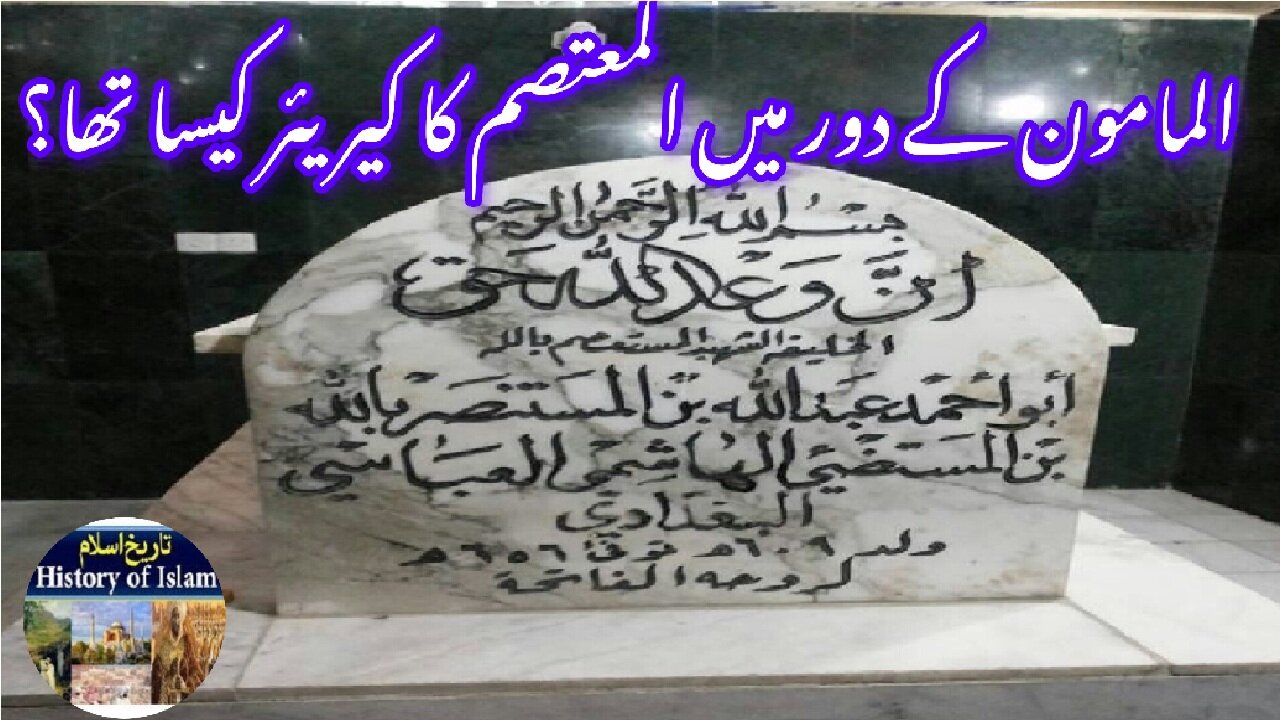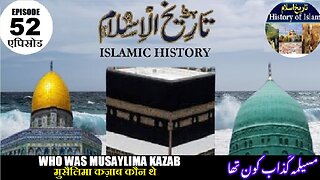Premium Only Content

How was Career of Al-Mutasim under al-Ma'mun | المعمون کے دور میں المتصم کا کیریئر کیسا رہا؟
@islamichistory813 #IslamicHistory #Leadership #AlMa'mun #Career #Al-Mutasim #al-Ma'mun
How was Career of Al-Mutasim under al-Ma'mun
Dekhti Aankhooon aur sountay kaanoon ko Asslamoalaikum, sisters, brothers friends and elders,In this islamic informative video, we are presnting the career of Al-Mutasim under the rule of al-Ma'mun, focusing on his strategic military campaigns and administrative reforms. We will describe how Al-Mutasim's leadership influenced the Abbasid Empire's trajectory and the legacy he left behind. This exploration provides insights into the dynamics of power during a pivotal era in Islamic history.
As an adult, Abu Ishaq Muhammad ibn Harun al-Mutasim was commonly called by his kunya, Abu Ishaq. Al-Tabari describes the adult Abu Ishaq as "fair-complexioned, with a black beard the hair tips of which were red and the end of which was square and streaked with red, and with handsome eyes". Other authors stress his physical strength and his love for physical activity—an anecdote recalls how during the Amorium campaign he went ahead of the army riding on a mule and searched in person for a ford across a river—in stark contrast to his more sedentary predecessors and successors. Later authors write that he was almost illiterate, but as the historian Hugh Kennedy comments, this "would have been most improbable for an Abbasid prince", and most likely reflects his lack of interest in intellectual pursuits.
As one of Harun's younger sons, Abu Ishaq was initially of little consequence, and did not figure in the line of succession. Soon after Harun died in 809, a vicious civil war broke out between his elder half-brothers al-Amin and al-Ma'mun . Al-Amin enjoyed the backing of the traditional Abbasid elites in Baghdad (the abna al-dawla), while al-Ma'mun was supported by other sections of the abna. Al-Ma'mun emerged victorious in 813 with the surrender of Baghdad after a long siege and the death of al-Amin. Choosing to remain in his stronghold in Khurasan, on the northeastern periphery of the Islamic world, al-Ma'mun allowed his main lieutenants to rule in his stead in Iraq. This resulted in a wave of antipathy towards al-Ma'mun and his "Persian" lieutenants, both among the Abbasid elites in Baghdad and generally in the western regions of the Caliphate, culminating in the nomination of Harun al-Rashid's younger brother Ibrahim as anti-caliph at Baghdad in 817. This event made al-Ma'mun realise his inability to rule from afar; bowing to popular reaction, he dismissed or executed his closest lieutenants, and returned in person to Baghdad in 819 to begin the difficult task of rebuilding the state.
Throughout the conflict and its aftermath, Abu Ishaq remained in Baghdad. Al-Tabari records that Abu Ishaq led the Hajj pilgrimage in 816, accompanied by many troops and officials, among whom was Hamdawayh ibn Ali ibn Isa ibn Mahan, who had just been appointed to the governorship of the Yemen and was on his way there. During his stay in Mecca, his troops defeated and captured a pro-Alid leader who had raided the pilgrim caravans. He also led the pilgrimage the following year, but no details are known. It appears that at least during this time, Abu Ishaq was loyal to al-Ma'mun and his viceroy in Iraq, al-Hasan ibn Sahl, but, like most members of the dynasty and the abn?? of Baghdad, he supported his half-uncle Ibrahim against al-Ma'mun in 817–819.
From c.?814/5, Abu Ishaq began forming his corps of Turkish troops. The first members of the corps were domestic slaves he bought in Baghdad (the distinguished general Itakh was originally a cook) whom he trained in the art of war, but they were soon complemented by Turkish slaves sent directly from the fringes of the Muslim world in Central Asia, under an agreement with the local Samanid rulers. This private force was small—it probably numbered between three and four thousand at the time of his accession to the throne—but it was highly trained and disciplined, and made Abu Ishaq a man of power in his own right, as al-Ma'mun increasingly turned to him for assistance. For the first time, special military uniforms were introduced for this praetorian Turkic guard.
The long civil war shattered the social and political order of the early Abbasid state; the abna al-dawla, the main political and military pillar of the early Abbasid state, had been much reduced by the civil war. Along with the abna, the old Arab families settled in the provinces since the time of the Muslim conquests, and the members of the extended Abbasid dynasty formed the core of the traditional elites and largely supported al-Amin. During the remainder of al-Ma'mun's reign they lost their positions in the administrative and military machinery, and with them their influence and power. Furthermore, as the civil war raged in the eastern half of the caliphate and in Iraq, the western provinces slipped from Baghdad's control in a series of rebellions that saw local strongmen claiming various degrees of autonomy or even trying to secede from the caliphate altogether. Although he had overthrown the old elites, al-Ma'mun lacked a large and loyal power base and army, so he turned to "new men" who commanded their own military retinues. These included the Tahirids, led by Abdallah ibn Tahir, and his own brother Abu Ishaq. Abu Ishaq's Turkish corps was politically useful to al-Ma'mun, who tried to lessen his own dependence on the mostly eastern Iranian leaders, such as the Tahirids, who had supported him in the civil war, and who now occupied the senior positions in the new regime. In an effort to counterbalance their influence, al-Ma'mun granted formal recognition to his brother and his Turkish corps. For the same reason he placed the Arab tribal levies of the Mashriq (the region of the Levant and Iraq) in the hands of his son, al-Abbas.
The nature and identity of the "Turkish slave soldiers", as they are commonly described, is a controversial subject; both the ethnic label and the slave status of its members are disputed. Although the bulk of the corps were clearly of servile origin, being either captured in war or purchased as slaves, in the Arabic historical sources they are never referred to as slaves (mamluk or abid), but rather as mawali ("clients" or "freedmen") or ghilman ("pages"), implying that they were manumitted, a view reinforced by the fact that they were paid cash salaries. Although members of the corps are collectively called simply "Turks", atrak, in the sources, prominent early members were neither Turks nor slaves, but rather Iranian vassal princes from Central Asia like al-Afshin, prince of Usrushana, who were followed by their personal retinues (Persian chakar, Arabic sh?kiriyya). Likewise, the motives behind the formation of the Turkish guard action are unclear, as are the financial means available to Abu Ishaq for the purpose, particularly given his young age. The Turks were closely associated with Abu Ishaq, and are usually interpreted as a private military retinue, something not uncommon in the Islamic world of the time. As the historian Matthew Gordon points out, the sources provide some indications that the original recruitment of Turks may have been begun or encouraged by al-Ma'mun, as part of the latter's general policy of recruiting Central Asian princes—and their own military retinues—to his court. It is therefore possible that the guard was originally formed on Abu Ishaq's initiative, but that it quickly received caliphal sanction and support, in exchange for being placed under al-Ma'mun's service.
Tomorow we will be described What and how were Service of Abu Ishaq under al-Ma'mun. So permission us upto tomorow. Allah Hafiz
===============================
-
 12:32
12:32
ISLAMIC HISTORY
9 hours agoTareekh-e-Islam Ep-52-एपिसोड Who was Musaylima Kazab मुसैलिमा कज़ाब कौन थे مسیلمہ کذاب کون تھا
261 -
 LIVE
LIVE
2 MIKES LIVE
2 hours ago2 MIKES LIVE #196 Deep Dive Monday!
212 watching -
 1:34:27
1:34:27
The Officer Tatum
3 hours agoLIVE: TRUTH About Mahmoud Khalil, Leftists LOSE IT OVER Maga Hat, Bill Maher to MEET Trump | EP 84
51K22 -
 2:02:38
2:02:38
Revenge of the Cis
5 hours agoEpisode 1463: Judge Moloch
53.3K8 -
 28:53
28:53
Kimberly Guilfoyle
6 hours agoInside the JFK Files with Roger Stone | Ep. 207
64.4K16 -
 1:21:07
1:21:07
vivafrei
8 hours agoRFK Jr. to Ban Pharma Ads? Pierre Poilievre Rally CRUSHING IT? The Boasberg Battle & MORE!
172K107 -
 1:04:24
1:04:24
In The Litter Box w/ Jewels & Catturd
1 day agoCONFLICT OF INTEREST | In the Litter Box w/ Jewels & Catturd – Ep. 767 – 3/24/2025
80.6K40 -
 2:14:54
2:14:54
The Quartering
8 hours agoAbsurd Epstein File Update, Trump Vs Supreme Court, Our Massive Giveaway, SodaGate & More!
293K453 -
 1:14:03
1:14:03
The HotSeat
4 hours agoOperation LET THEM SPEAK + Your Calls!
36.6K4 -
 34:44
34:44
LFA TV
4 hours agoMIRACLES DO HAPPEN!
25.2K